Abstract
Cilofungin (LY121019) is an antifungal agent that interferes with beta-glucan synthesis in the cells walls of fungi. The activity of this agent against 256 clinical isolates of yeasts was determined. It was found to be very active in vitro against Candida albicans (MIC for 90% of isolates [MIC90], less than or equal to 0.31 microgram/ml; minimal fungicidal concentration for 90% of isolates [MFC90], less than or equal to 0.31 micrograms/ml) and C. tropicalis (MIC90, less than or equal to 0.31 microgram/ml; MFC90, less than or equal to 0.31 microgram/ml) and moderately active against Torulopsis glabrata (MIC90 and MFC90, less than or equal to 20 micrograms/ml). All C. parapsilosis, Cryptococcus, and Saccharomyces cerevisiae strains were resistant. The activity of cilofungin was affected by medium and inoculum size. Antibiotic medium no. 3 was used as the standard medium. Isolates of C. albicans and C. tropicalis demonstrated a paradoxical effect in Sabouraud dextrose broth and yeast nitrogen base broth in that growth was partially inhibited at MICs equivalent to those in antibiotic medium no. 3, but growth continued, in many instances, throughout all concentrations tested. There was decreased activity of cilofungin with inocula greater than 10(5) CFU/ml. The temperature and duration of incubation did not affect its activity.
Full text
PDF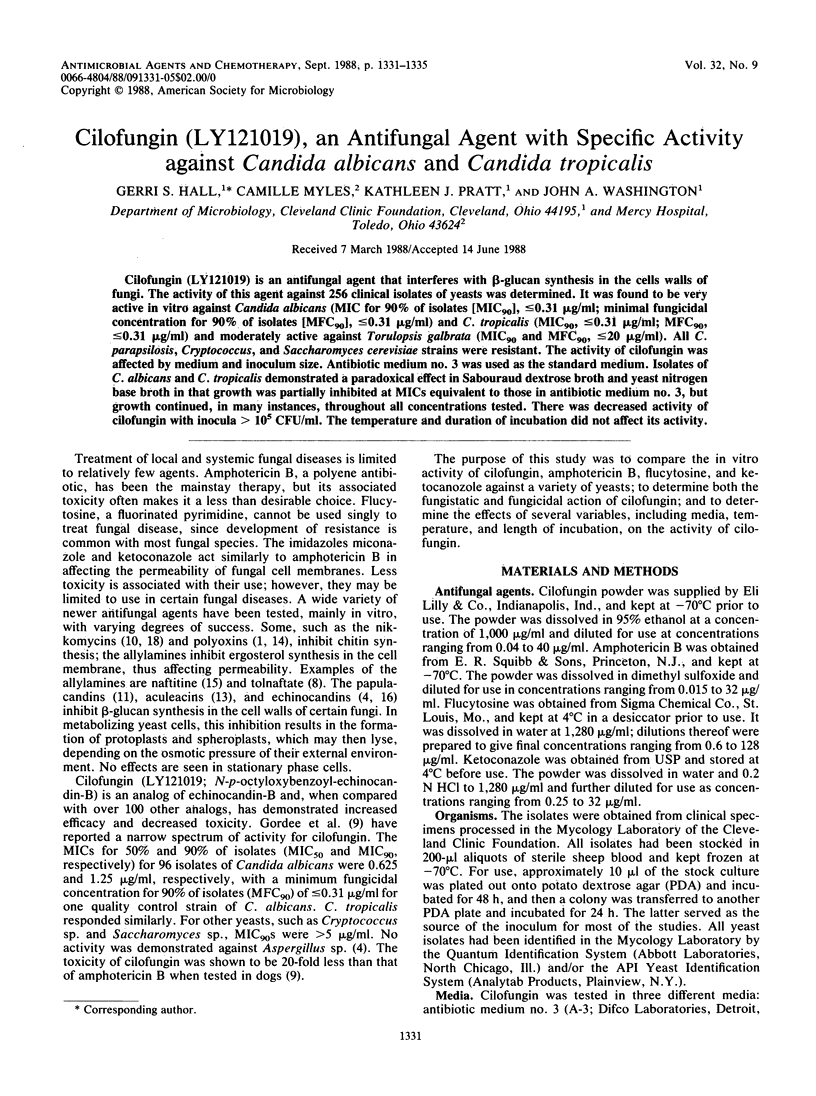
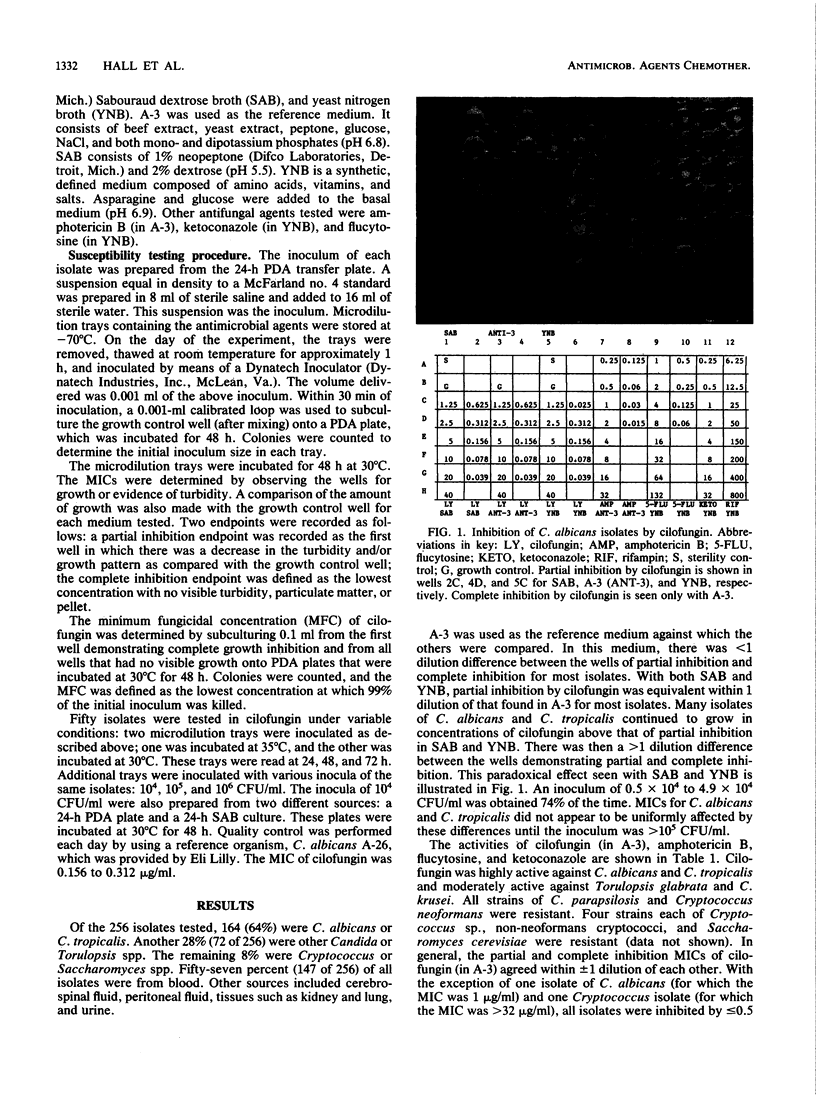
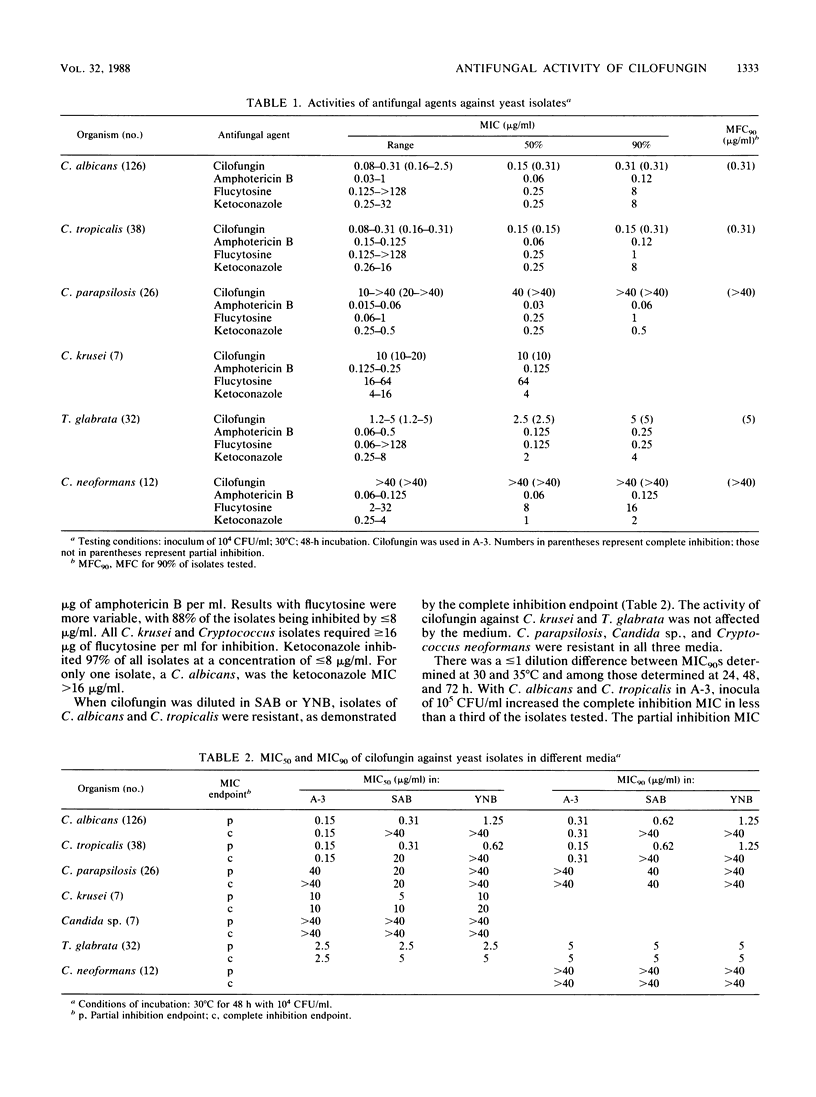
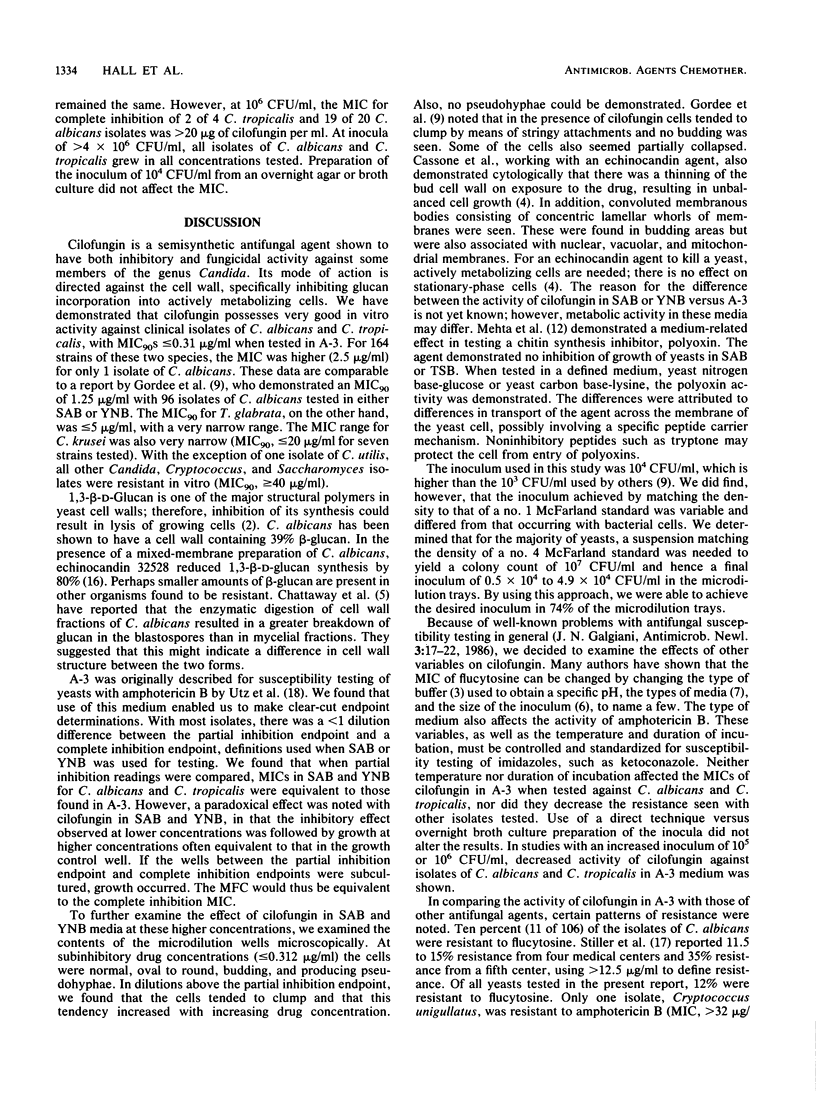
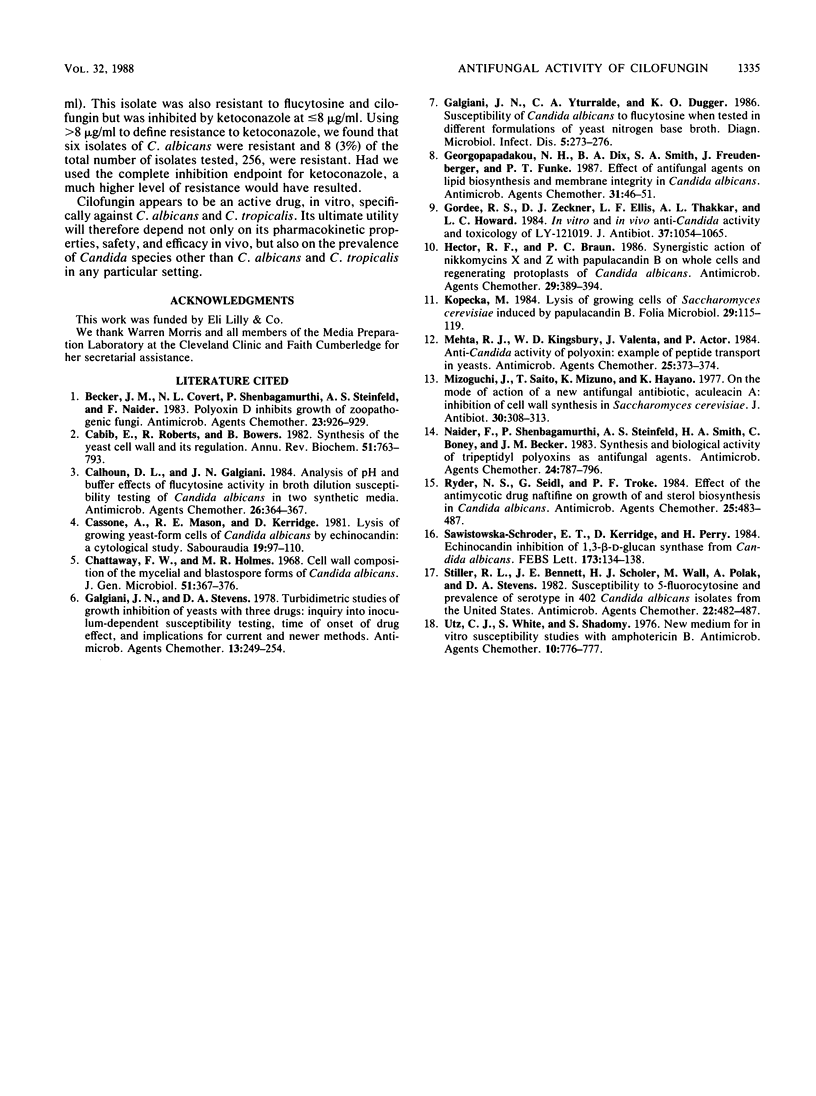
Images in this article
Selected References
These references are in PubMed. This may not be the complete list of references from this article.
- Becker J. M., Covert N. L., Shenbagamurthi P., Steinfeld A. S., Naider F. Polyoxin D inhibits growth of zoopathogenic fungi. Antimicrob Agents Chemother. 1983 Jun;23(6):926–929. doi: 10.1128/aac.23.6.926. [DOI] [PMC free article] [PubMed] [Google Scholar]
- Cabib E., Roberts R., Bowers B. Synthesis of the yeast cell wall and its regulation. Annu Rev Biochem. 1982;51:763–793. doi: 10.1146/annurev.bi.51.070182.003555. [DOI] [PubMed] [Google Scholar]
- Calhoun D. L., Galgiani J. N. Analysis of pH and buffer effects on flucytosine activity in broth dilution susceptibility testing of Candida albicans in two synthetic media. Antimicrob Agents Chemother. 1984 Sep;26(3):364–367. doi: 10.1128/aac.26.3.364. [DOI] [PMC free article] [PubMed] [Google Scholar]
- Cassone A., Mason R. E., Kerridge D. Lysis of growing yeast-form cells of Candida albicans by echinocandin: a cytological study. Sabouraudia. 1981 Jun;19(2):97–110. [PubMed] [Google Scholar]
- Chattaway F. W., Holmes M. R., Barlow A. J. Cell wall composition of the mycelial and blastospore forms of Candida albicans. J Gen Microbiol. 1968 May;51(3):367–376. doi: 10.1099/00221287-51-3-367. [DOI] [PubMed] [Google Scholar]
- Galgiani J. N., Yturralde C. A., Dugger K. O. Susceptibility of Candida albicans to flucytosine when tested in different formulations of yeast nitrogen base broth. Diagn Microbiol Infect Dis. 1986 Sep;5(3):273–276. doi: 10.1016/0732-8893(86)90012-x. [DOI] [PubMed] [Google Scholar]
- Galgiant J. N., Stevens D. A. Turbidimetric studies of growth inhibition of yeasts with three drugs: inquiry into inoculum-dependent susceptibility testing, time of onset of drug effect, and implications for current and newer methods. Antimicrob Agents Chemother. 1978 Feb;13(2):249–254. doi: 10.1128/aac.13.2.249. [DOI] [PMC free article] [PubMed] [Google Scholar]
- Georgopapadakou N. H., Dix B. A., Smith S. A., Freudenberger J., Funke P. T. Effect of antifungal agents on lipid biosynthesis and membrane integrity in Candida albicans. Antimicrob Agents Chemother. 1987 Jan;31(1):46–51. doi: 10.1128/aac.31.1.46. [DOI] [PMC free article] [PubMed] [Google Scholar]
- Gordee R. S., Zeckner D. J., Ellis L. F., Thakkar A. L., Howard L. C. In vitro and in vivo anti-Candida activity and toxicology of LY121019. J Antibiot (Tokyo) 1984 Sep;37(9):1054–1065. doi: 10.7164/antibiotics.37.1054. [DOI] [PubMed] [Google Scholar]
- Hector R. F., Braun P. C. Synergistic action of nikkomycins X and Z with papulacandin B on whole cells and regenerating protoplasts of Candida albicans. Antimicrob Agents Chemother. 1986 Mar;29(3):389–394. doi: 10.1128/aac.29.3.389. [DOI] [PMC free article] [PubMed] [Google Scholar]
- Kopecká M. Lysis of growing cells of Saccharomyces cerevisiae induced by papulacandin B. Folia Microbiol (Praha) 1984;29(2):115–119. doi: 10.1007/BF02872926. [DOI] [PubMed] [Google Scholar]
- Mehta R. J., Kingsbury W. D., Valenta J., Actor P. Anti-Candida activity of polyoxin: example of peptide transport in yeasts. Antimicrob Agents Chemother. 1984 Mar;25(3):373–374. doi: 10.1128/aac.25.3.373. [DOI] [PMC free article] [PubMed] [Google Scholar]
- Mizoguchi J., Saito T., Mizuno K., Hayano K. On the mode of action of a new antifungal antibiotic, aculeacin A: inhibition of cell wall synthesis in Saccharomyces cerevisiae. J Antibiot (Tokyo) 1977 Apr;30(4):308–313. doi: 10.7164/antibiotics.30.308. [DOI] [PubMed] [Google Scholar]
- Naider F., Shenbagamurthi P., Steinfeld A. S., Smith H. A., Boney C., Becker J. M. Synthesis and biological activity of tripeptidyl polyoxins as antifungal agents. Antimicrob Agents Chemother. 1983 Nov;24(5):787–796. doi: 10.1128/aac.24.5.787. [DOI] [PMC free article] [PubMed] [Google Scholar]
- Ryder N. S., Seidl G., Troke P. F. Effect of the antimycotic drug naftifine on growth of and sterol biosynthesis in Candida albicans. Antimicrob Agents Chemother. 1984 Apr;25(4):483–487. doi: 10.1128/aac.25.4.483. [DOI] [PMC free article] [PubMed] [Google Scholar]
- Sawistowska-Schröder E. T., Kerridge D., Perry H. Echinocandin inhibition of 1,3-beta-D-glucan synthase from Candida albicans. FEBS Lett. 1984 Jul 23;173(1):134–138. doi: 10.1016/0014-5793(84)81032-7. [DOI] [PubMed] [Google Scholar]
- Stiller R. L., Bennett J. E., Scholer H. J., Wall M., Polak A., Stevens D. A. Susceptibility to 5-fluorocytosine and prevalence of serotype in 402 Candida albicans isolates from the United States. Antimicrob Agents Chemother. 1982 Sep;22(3):482–487. doi: 10.1128/aac.22.3.482. [DOI] [PMC free article] [PubMed] [Google Scholar]
- Utz C. J., White S., Shadomy S. New medium for in vitro susceptibility studies with amphotericin B. Antimicrob Agents Chemother. 1976 Oct;10(4):776–777. doi: 10.1128/aac.10.4.776. [DOI] [PMC free article] [PubMed] [Google Scholar]



